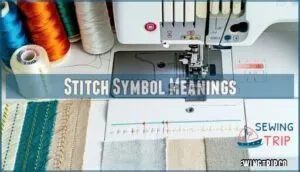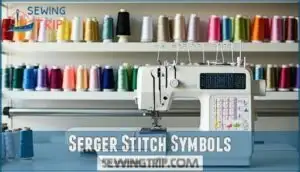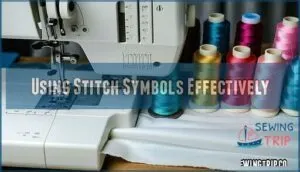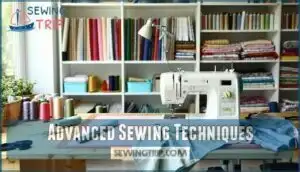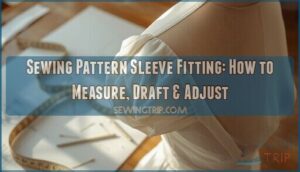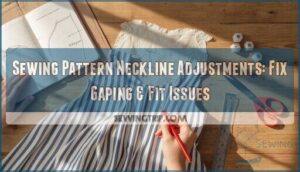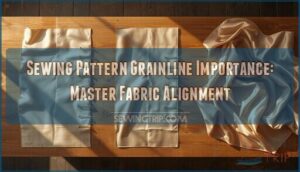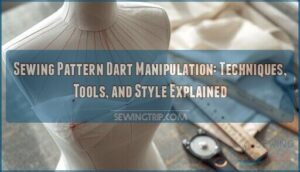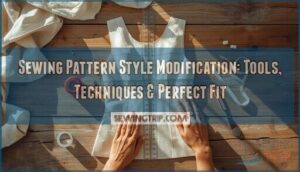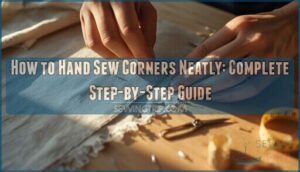This site is supported by our readers. We may earn a commission, at no cost to you, if you purchase through links.
Icons and stitch symbols on your sewing machine and serger act like a roadmap for your projects.
They guide you to select the right stitch for straight seams, stretchy fabrics, or decorative finishes. For example, a straight line icon usually means a basic straight stitch, while a zigzag symbol handles stretchy or fraying fabrics.
Sergers often feature overlock stitch icons for clean edges or blind hem symbols for invisible hems. Understanding these symbols helps you match stitches to fabric types, adjust tension, and troubleshoot issues.
Once you master these, stitching becomes second nature—your machine practically speaks your language, and you can achieve clean edges with ease.
Table Of Contents
Key Takeaways
- Learn sewing machine and serger icons to confidently match stitches to fabric types and get the best results.
- Use guidebooks and stitch settings to troubleshoot issues like skipped stitches or puckering before tackling projects.
- Adjust stitch length , width, and tension for different fabrics, ensuring smooth, durable, and professional seams.
- Decorative and specialty stitches add flair to projects—experiment with symbols and settings to unlock creative possibilities.
Sewing Machine Icons
Understanding sewing machine icons lets you quickly select the right stitch for any project. These symbols act as your machine’s visual guide, making sewing more efficient and enjoyable.
Basic Stitch Symbols
Understanding basic stitch symbols is like cracking a secret code for your sewing projects.
These icons, found on your machine, represent stitches like straight, zigzag, or blind hem.
Symbol standardization varies by brand, so check your manual.
A stitch symbol guide helps decode meanings, ensuring machine compatibility.
Learning resources simplify symbol evolution, bridging gaps between modern and obsolete symbols.
Decorative Stitch Symbols
Decorative stitch symbols add flair to your projects, turning plain fabric into art. These sewing machine icons showcase stitch complexity and symbol aesthetics, inspiring creativity.
Turn simple fabrics into masterpieces with decorative stitch symbols that spark creativity and showcase intricate, artistic designs.
From scallop to honeycomb designs, they’re part of a rich icon glossary sewing enthusiasts love. The stitch reference guide helps sewers familiarize themselves with popular stitches.
- Create vintage vibes with shell tuck stitches.
- Add elegance using satin stitches.
- Explore tree-inspired patterns.
- Design unique edges with scallop stitches.
- Experiment with custom symbols for personal flair.
Stretch and Knit Fabric Symbols
When tackling stretch or knit fabrics, sewing machine symbols and serger machine symbols are your best friends.
The Knit Symbol Guide helps identify stretch-friendly stitches like triple zigzag or elastic overlock.
Use Fabric Feed Settings or Differential Feed Use to prevent puckering.
Adjust the Tension Dial Impact for smooth seams.
Each stitch symbol meaning guarantees your sewing machine stitches suit knit fabrics perfectly.
Stitch Symbol Meanings
Stitch symbols on your machine aren’t just random shapes—they tell you exactly what kind of stitch you’ll get and its purpose.
Understanding these symbols helps you pick the right stitch for your project without second-guessing, and this understanding is crucial for the project.
Straight Stitch Symbols
Straight stitch symbols often represent the most versatile sewing machine stitches.
Straight stitch symbols unlock endless possibilities, guiding you to create clean, precise seams for any fabric or project.
They guide you on needle position, stitch length, and tension settings for various fabric types.
Some machines let you adjust the needle far left for precise edges.
Symbol variations may differ, so always check your manual.
Mastering these symbols guarantees clean seams and boosts your sewing confidence.
For professional results, to achieve this, understand different stitch patterns.
Zig Zag Stitch Symbols
Zig zag stitch symbols are versatile, showing stitch pattern icons that adapt to various tasks.
These sewing machine stitch icons often allow width adjustments and density settings, making them ideal for stretchy fabrics or decorative edges.
Symbol variations depend on your machine, so check the applications guide.
Troubleshooting symbols? Test on scraps to master icon identification sewing with ease!
Blind Hem Stitch Symbols
Blind hem stitch symbols simplify creating nearly invisible hems.
These stitch pattern icons vary by machine, so check your icon reference chart.
For thicker fabrics, adjust tension settings and use appropriate needle types.
Stitch visibility depends on proper alignment and fabric thickness.
A blind hem foot guarantees accuracy.
A specialized foot guarantees accuracy, making sewing machine stitch icons a handy guide for flawless, professional hems, with proper alignment being key.
Buttonhole Stitch Symbols
Buttonhole stitches are your go-to for making buttonholes on shirts, jackets, or coats.
Their symbols vary by machine, so check your icon reference chart. Use a specialized presser foot for clean results and tweak settings for fabric suitability.
- Buttonhole Types: Keyhole, round, or standard.
- Machine Settings: Adjust stitch width and length.
- Troubleshooting Buttonholes: Test on scrap fabric first.
Serger Stitch Symbols
Serger stitch symbols help you understand the unique stitches your machine can create, from overlock seams to decorative edges.
By recognizing these symbols, you’ll save time and achieve professional-looking finishes effortlessly, which is made possible by understanding the unique stitches.
Overlock Stitch Symbols
Overlock stitch symbols can vary by brand, reflecting differences in serger stitch types and capabilities.
These symbols often mimic crochet patterns, showing the interlocking loops unique to sergers. A good stitch guide helps decode these variations, ensuring symbol clarity.
Understanding serger symbol meanings is essential for accurate stitch selection.
If troubleshooting symbols confuses you, remember that overlock stitches excel at finishing edges and handling stretch fabrics with ease.
Stretch Blind Hem Symbols
Stretch blind hem symbols guide you to create nearly invisible hems on stretchy fabrics. These symbols help match the right stitch to your fabric and prevent breakage during wear.
- Blind Hem Application: Ideal for stretchy garments.
- Fabric Selection: Works on knits and stretch fabrics.
- Symbol Variations: Check your machine’s stitch directory sewing options.
- Machine Settings: Adjust tension for smooth results.
- Troubleshooting Issues: Test on scraps to avoid puckering.
Elastic Shell Tuck Symbols
Elastic Shell Tuck Symbols guide you in creating delicate, scalloped edges perfect for lightweight fabrics.
This elastic stitch variation works well on knits, adding flexibility without sacrificing beauty.
Adjust your stitch length for the desired effect, and pay attention to fabric suitability to avoid puckering.
Understanding different stitch patterns is essential for achieving the best results on various fabrics.
If troubleshooting issues arise, check tension settings or consult your sewing machine stitches manual for clarity.
Using Stitch Symbols Effectively
Understanding stitch symbols helps you pick the right stitch for your fabric and project.
With a few adjustments to length and width, you can troubleshoot issues and achieve professional results effortlessly.
Choosing Right Stitch for Fabric
Matching stitch types to your fabric is like finding the perfect dance partner.
Light fabrics need gentler sewing machine stitches, while heavier ones demand sturdier options.
Adjust stitch tension to avoid puckering, and pair your needle choice with thread for smooth results.
Use serger stitch settings for stretchy fabrics and verify the seam allowance suits your project’s needs.
Adjusting Stitch Length and Width
Adjusting stitch length and width can transform your sewing.
It’s key to match fabric thickness, thread type, and desired decorative effects.
Use these tips:
- Shorten stitch length for dense fabrics.
- Widen zigzag stitches for stretchy seams.
- Adjust serger stitch settings for neat edges.
- Test stitch density on scraps first.
- Align tension settings with stitch width.
Troubleshooting Common Stitch Issues
Skipped stitches or fabric puckering?
It’s likely tension problems or needle issues. Check your stitch settings and confirm the needle matches the fabric.
Thread breaks during serger troubleshooting? Inspect the overlock stitch tension.
Here’s a quick guide:
Use correct needle
Low tension
Advanced Sewing Techniques
Mastering advanced sewing techniques lets you handle tricky fabrics and create professional finishes with ease.
From using twin needles to adjusting foot pressure, you’ll access your machine’s full potential.
Sewing Knit Fabrics With Serger
To master sewing stretchy fabrics with a serger, start with the right serger needle types and serger thread choices.
Adjust differential feed settings to prevent puckering or stretching. Use a stretch stitch or overlocking stitch for durability.
For delicate edges, try a rolled hem on knits. Proper knit fabric tension guarantees smooth seams, perfect for elastic sewing projects.
Using Twin Needles for Hem Finishes
Using a twin needle transforms your sewing machine into a hem-finishing pro.
Choose the right twin needle type—standard or stretch needle—based on fabric compatibility.
Decorative hems on knits or wovens look professional with proper tension adjustments.
Experiment with sewing machine stitches for smooth results.
For those interested, twin needle options are widely available.
Troubleshooting tips: reduce skipped stitches by using quality needles and checking thread tension to achieve smooth results with the right tension adjustments.
Foot Pressure Adjustment for Better Stitches
Struggling with fabric feed issues or uneven stitches? Adjusting your sewing machine foot pressure can make all the difference.
Heavier material thickness might need more pressure, while lighter fabrics require less to prevent puckering.
Pair this with proper tension balance and needle compatibility to fine-tune for smoother, consistent results, and check your sewing machine settings and stitch settings.
Identifying and Using Specialized Stitches
Identifying specialized stitches can elevate your sewing game. Here’s how to make the most of them:
- Use Fabric-Specific Stitches like overlock for knits or decorative stitches for accents.
- Match stitches with Needle Compatibility for smooth results.
- Fine-tune Tension Adjustments to prevent puckering.
- Regularly check Maintenance Tips to keep your machine’s stitch settings reliable.
Experimenting with stitch density guarantees professional design results.
A thoughtful approach guarantees perfection!
Frequently Asked Questions (FAQs)
What are the 7 types of stitches?
They say, "A stitch in time saves nine," and it’s true!
The seven types of stitches include straight, zigzag, blind hem, buttonhole, overlock, stretch, and decorative.
Each serves a unique purpose for sewing projects, and understanding these can be crucial as complete concepts are key to successful sewing.
What are the different stitch settings on a sewing machine?
A sewing machine offers various stitch settings like straight, zigzag, blind hem, buttonhole, and overlock.
Each serves unique purposes, from basic seams to decorative finishes, providing versatility for projects requiring strength, stretch, or flair.
Are the stitch symbols the same across all brands of machines?
Think all stitch symbols are universal? Not quite!
Each brand uses its own designs, though common stitches often look similar.
Always consult your machine’s manual to decode icons and get the best results.
What type of stitch is best for finishing elastic?
The best stitch for finishing elastic is a zigzag stitch or an elastic overlock stitch.
These stitches allow flexibility and strength while preventing fraying.
Adjust stitch length and test on scrap fabric before starting.
When should a shorter stitch length be used?
When precision counts—like sewing dense fabrics, making buttonholes, or adding delicate details—shorter stitch lengths shine.
They create stronger seams, prevent skipped stitches, and offer better control, especially on curves or intricate designs.
How to identify stitches on vintage machines?
Inspect the stitch dial or knobs for symbols or numbers matching common stitch patterns.
Check the manual, if available, for explanations.
Experiment on scrap fabric to identify what each setting produces while adjusting tension or length.
What is the purpose of lightning stitch?
Over 70% of sewists prefer zigzag stitches, yet the lightning stitch excels for stretchy fabrics.
Its narrow, angled design prevents seam breakage and puckering, offering durability and flexibility—perfect for activewear or knit projects.
Can overlock stitches replace a serger completely?
Overlock stitches on a sewing machine mimic a serger’s finish but can’t fully replace it.
Sergers trim fabric and create stronger, stretchier seams, making them essential for professional results, especially with knits and stretchy materials.
Are specific stitches needed for heavy fabric?
For heavy fabrics, use a straight stitch with a longer length, reinforced stitches like double overlock or triple straight stitch, and sturdy thread.
Adjust your machine’s tension and use a heavy-duty needle for best results.
How does stitch length affect appearance?
A short stitch length creates tight, precise seams, perfect for delicate fabrics or detailed work.
Longer stitches, by contrast, look bolder and work well for topstitching or temporary basting.
Adjust length to match your fabric’s needs, considering the delicate fabrics for optimal results.
Conclusion
Think of icons and stitch symbols on your sewing machine and serger as a treasure map guiding you to professional results.
By knowing these symbols, you’ll easily match stitches to fabric types, tweak settings, and avoid common mistakes.
Whether you’re securing stretchy seams, finishing clean edges, or adding decorative flair, understanding these symbols makes sewing more intuitive.
Master them, and your machine transforms into your creative partner, ready to tackle any project with precision and ease.

